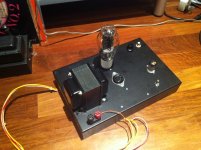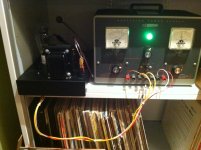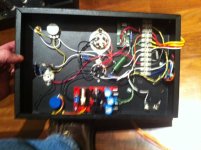I've been experimenting with the Simple 45 topology in my MONO system, using a Heathkit regulated Power Supply, and rolling tubes and Output Transformers.
Tried 45/2A3/300B triodes with Edcor 5Ks OPTs (the $20 and the $34 ones) and HandWound 3Ks. The clear winner here is (no surprise) the 300B with the 3K Handwounds.
Also tried 46 in triode and ultra-Linear with the Edcors; the Ultra-linear was surprisingly, uh, "lyrical" is the word folks use. I think I like it better than the 45 with the same OPTs.
Also have a pair of the BIG Edcors (5K), a couple pairs of "Transcendars" (3K and 5K) and a couple of pairs of the open-frame Hammonds that are in the queue.
Eventually, I would like to build permanent versions of the best configurations, both Stereo and Mono (or maybe a "fleet" of monoblocks).
Here's the question: has anybody compared SET amps with and without regulated B+ power supplies? I've build about a dozen SETs, but never used regulated power supply before this. It SEEMS like the combination of a regulated driver and regulated power tube works pretty well, but I don't have a direct comparison. One huge advantage, of course, is that changing the operating point is a snap.
Kevin Kennedy's "Dirt Cheap 45", for example,uses separate regulated supplies for driver and power tubes (6550 and EL84 pass tubes, which seems pretty extravagant). He seems pretty convinced.
45 S.E Stereo Amplifier
For pass tubes, I have 6L6GCs, 6AV5GAs, 6AU5GTs and a 6AS7 available, plus a bunch of 6AU6 pentodes for the error amplifier.
If you use the cheaper TV sweep tubes, the added expense of regulating B+ is pretty small.
I assume that a healthy choke filter is called-for, but I would do that in an unregulated supply anyway.
How about regulator tubes (e.g. 0A2) versus thyristors? I haven't used thyristors in an HV regulated supply before; they require cap by-pass, but they have the advantage that the voltage is the same every time you turn it on.
Any thoughts? or do I just need to do a direct comparison?
Here are some photos. Notice the paralleled 4 an 5 pin sockets and the Pete Millett regulated DC filament supply board (voltage set with a 10-turn pot on the chassis). The Euro terminal strip makes changing OPTs really easy,
Tried 45/2A3/300B triodes with Edcor 5Ks OPTs (the $20 and the $34 ones) and HandWound 3Ks. The clear winner here is (no surprise) the 300B with the 3K Handwounds.
Also tried 46 in triode and ultra-Linear with the Edcors; the Ultra-linear was surprisingly, uh, "lyrical" is the word folks use. I think I like it better than the 45 with the same OPTs.
Also have a pair of the BIG Edcors (5K), a couple pairs of "Transcendars" (3K and 5K) and a couple of pairs of the open-frame Hammonds that are in the queue.
Eventually, I would like to build permanent versions of the best configurations, both Stereo and Mono (or maybe a "fleet" of monoblocks).
Here's the question: has anybody compared SET amps with and without regulated B+ power supplies? I've build about a dozen SETs, but never used regulated power supply before this. It SEEMS like the combination of a regulated driver and regulated power tube works pretty well, but I don't have a direct comparison. One huge advantage, of course, is that changing the operating point is a snap.
Kevin Kennedy's "Dirt Cheap 45", for example,uses separate regulated supplies for driver and power tubes (6550 and EL84 pass tubes, which seems pretty extravagant). He seems pretty convinced.
45 S.E Stereo Amplifier
For pass tubes, I have 6L6GCs, 6AV5GAs, 6AU5GTs and a 6AS7 available, plus a bunch of 6AU6 pentodes for the error amplifier.
If you use the cheaper TV sweep tubes, the added expense of regulating B+ is pretty small.
I assume that a healthy choke filter is called-for, but I would do that in an unregulated supply anyway.
How about regulator tubes (e.g. 0A2) versus thyristors? I haven't used thyristors in an HV regulated supply before; they require cap by-pass, but they have the advantage that the voltage is the same every time you turn it on.
Any thoughts? or do I just need to do a direct comparison?
Here are some photos. Notice the paralleled 4 an 5 pin sockets and the Pete Millett regulated DC filament supply board (voltage set with a 10-turn pot on the chassis). The Euro terminal strip makes changing OPTs really easy,
Attachments
I started out by writing a long reply to your comments on my old 45 amp design, but of somehow I lost the whole thing.. (Not sure how)
Anyway the current amplifier in my system which is a D3A IT coupled to a GM70 does not use voltage regulation for a variety of reasons from concerns about efficiency/heat to safety. I did not want a design where I need to poke around inside an energized chassis to determine why it wasn't working as intended. The plate supply is an unnerving 1kV.. (I have not needed to poke around inside the fully energized chassis)
(I have not needed to poke around inside the fully energized chassis)
I have come to the conclusion that fixed bias, and low impedance/low noise supply design are equally if not more important than voltage regulation which I continue to use in line and phono stage designs. It may also be that I am getting lazier/deafer in my old age and just can't be bothered to build something that complex..
and just can't be bothered to build something that complex..  In my defense I will say the GM70 design is a significantly better performer than the fully regulated 300B design it replaced - other things come into play however. (Not the least of which is 13yrs of additional design experience between these two amps.)
In my defense I will say the GM70 design is a significantly better performer than the fully regulated 300B design it replaced - other things come into play however. (Not the least of which is 13yrs of additional design experience between these two amps.)
Anyway the current amplifier in my system which is a D3A IT coupled to a GM70 does not use voltage regulation for a variety of reasons from concerns about efficiency/heat to safety. I did not want a design where I need to poke around inside an energized chassis to determine why it wasn't working as intended. The plate supply is an unnerving 1kV..
I have come to the conclusion that fixed bias, and low impedance/low noise supply design are equally if not more important than voltage regulation which I continue to use in line and phono stage designs. It may also be that I am getting lazier/deafer in my old age
 and just can't be bothered to build something that complex..
and just can't be bothered to build something that complex.. I tend to leave out the choke and connect 6550/6L6/6V6/6BQ5 pass tubes for pentode/tetrode mode (as appropriate) and have found that generally a choke is not required as a well filtered screen supply and adequate feedback margin will suffice to get an adequately low level of output ripple. (With careful design a couple of mV of ripple or less on the output is possible.) I have had some LF stability issues with regulators used in conjunction with CLC filtered raw supplies - both in simulation and in real life.
For pass tubes, I have 6L6GCs, 6AV5GAs, 6AU5GTs and a 6AS7 available, plus a bunch of 6AU6 pentodes for the error amplifier.
I wouldn't waste five minutes on a series regulator. Just use a Salas high voltage shunt and you won't recognise the sound of your amp. If you have issues with SS shunts, some high current VR tubes are available but getting exact voltages is a problem. As for the current source- nothing beats SS.
I've been experimenting with the Simple 45 topology in my MONO system, using a Heathkit regulated Power Supply,
All of my experiments with the Simple 45 and the original TSE design were done with a Knight variable supply very similar to your Heathkit.
I have come to the conclusion that fixed bias, and low impedance/low noise supply design are equally if not more important than voltage regulation
A low and constant power supply impedance across the ENTIRE audio frequency range and beyond combined with a well designed fixed bias amp (the bias must not shift no matter what you do to the amps input) IS the way to magic sound. You can get lucky with the right combination of passive power supply components, or you can build a regulator with a low output impedance.
I have designed two different external power supplies for the TSE, but life has been too hectic lately to make a proper PC board for either one. One is tube the other SS. I have been using the SS one. It sounds a bit better than the Knight / Heathkit. It gets the high voltage off the mosfets which cuts the heat and allows a bit more current.
The clear winner here is (no surprise) the 300B with the 3K Handwounds.
Are we talking about David Lucas the con artist Handwounds? His early stuff was pretty good, then he started shipping junk, then he just stole the money and sent nothing. I have two pairs of the good ones.
http://www.diyaudio.com/forums/tubes-valves/13932-handwound-transformers-com.html
- Status
- This old topic is closed. If you want to reopen this topic, contact a moderator using the "Report Post" button.


